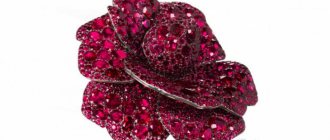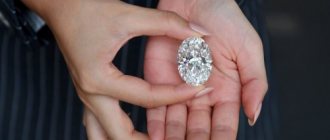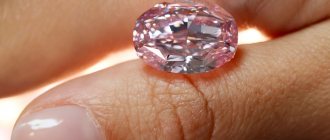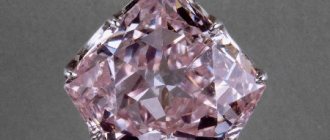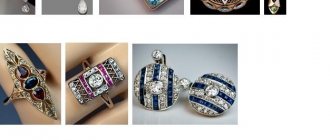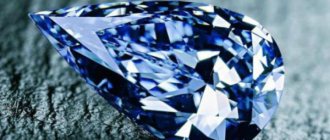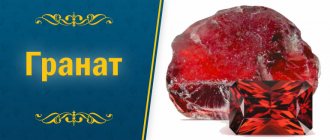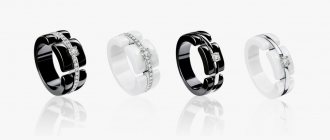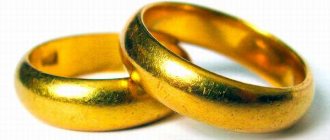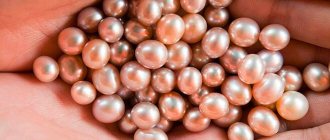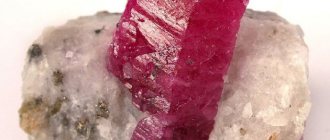BRAND HISTORY VAN CLEEF & ARPELS
The history of the brand began with a love story between two people: Estelle Arpels and Alfred Van Cleef. She is the daughter of a gem dealer, he is the son of a lapidary. The couple had a lot in common: ambition, love of beauty and respect for precious stones.
In 1906, Alfred and Estelle's brother Charles Arpels opened a jewelry boutique on Place Vendôme in Paris. This marked the beginning of a large family business and a legendary jewelry house. Van Cleef & Arpels focus on exquisite design, emphasizing that they work only with the best stones and employ the best jewelers.
Estelle Arpels and Alfred Van Cleef, Van Cleef & Arpels boutique
From the first days of work, the House carried out special orders. His clients included the Duke and Duchess of Windsor (the same British monarch who abdicated the throne to marry his beloved), the princesses of Egypt and India, Grace Kelly and Jacqueline Kennedy. No woman who loves jewelry could resist the charm of Van Cleef & Arpels.
In 1966, Van Cleef & Arpels received the most prestigious commission in its history: a crown for the Empress of Iran, Farah Pahlavi.
To select suitable stones, Pierre Arpels went to Tehran, where he spent days in the State Treasury. A jewelry workshop was also equipped there, where six months later a unique crown was created.
Almost one and a half thousand diamonds, 36 emeralds, rubies, pearls... The weight of the product was 1,600 grams.
Crown of Farah Pahlavi
Numerous patents, awards at international exhibitions, complex special orders and famous clients - all this is the past and present of Van Cleef & Arpels.
In 1940, a boutique was opened in New York, which became the first branch of the House outside Paris. Today there are dozens of boutiques on four continents.
In the 1920s, the first watches under the Van Cleef & Arpels brand were produced, and in the 1970s, the first fragrance.
In the windows of the French House you can find both traditional feminine jewelry that could easily decorate your great-grandmother’s outfit, and quite modern jewelry. In 2012, the L'Ecole Van Cleef & Arpels school was opened in Paris, where the masters of the famous house share their secrets.
VAN CLEEF & ARPELS ACCESSORIES
At the beginning of the last century, the time came for ladies to get rid of complex hairstyles and corsets; they were allowed to dance and have fun until the morning and even powder their noses in front of everyone. Women had to take cosmetic bags with them. To make this accessory truly sophisticated, Van Cleef & Arpels suggested adding jewelry. Cigarette cases, cosmetic bags, and then minaudieres decorated with precious stones became a sign of good taste and high status.
Precious toilet case Roses Minaudière, 1926
Precious travel case Daisy Minaudière, 1953
Precious travel case Haliades minaudière, 2007
TRANSFORMERS JEWELRY VAN CLEEF & ARPELS
There is no limit to perfection, masterfully handling stones and metals, Van Cleef & Arpels jewelers have created something that no one has ever done before.
Passe-Partout is a clever system that allows the gold snake to be worn in seven different ways: as a choker, short necklace, long necklace, bracelet and belt, while the flowers can be worn as earrings or as a brooch. The perfect precious transformer!
Passe-Partout necklace, 1939
Passe-Partout advertisement, 1939
But another transformer has become truly iconic - the Zip necklace. The idea to turn a zipper into an exquisite decoration belongs to the Duchess of Windsor. The first sketches and patent from Van Cleef & Arpels appeared in the late 1930s. The idea was realized only in 1950. The House continues to produce this iconic model in a variety of designs to this day.
Zip necklace, 1951
Zip necklace with lapis lazuli and white mother of pearl, 2011
Flower earrings
In the Tendresse etincelante earrings, the jewelry house turns to equally unique precious stones and the theme of nature. On each of the earrings an inflorescence blooms with a diamond “core”. The petals, decorated with fine veins, gain verisimilitude thanks to graceful curves and relief. The precious flowers are complemented by removable pendants of two pear-shaped diamonds weighing a total of 20.21 carats. These stones (weighing over 10 carats each) are remarkable because they were cut from the same rough piece of the mineral.
Tendresse etincelante earrings with detachable pendants, 2021. White gold and diamonds, two pear-shaped diamonds (DFL/2A) totaling 20.21 ct. Photo: Van Cleef & Arpels
The piece is inspired by the Van Cleef & Arpels earrings that Aristotle Onassis gave Jacqueline as a wedding gift in 1968. She has appeared in public more than once wearing these large “flower” earrings with diamond inlay and pendants in the form of cabochon rubies.
Earrings made of gold with diamonds and rubies, 1968. Gifted to Jacqueline Kennedy Onassis by Aristotle Onassis, private collection. Photo: Van Cleef & Arpels
BALLERINAS AND FAIRIES VAN CLEEF & ARPELS
In the early 1940s, the famous Ballerina brooches appeared. Graceful dancers are decorated with diamonds, rubies and emeralds. Following them, fairy fairies and cartoon characters of those days appeared. The jewelry quickly became popular, and the public saw it as a symbol of hope and freedom during the dark days of war.
Danseuse Espagnole brooch, 1941
Ballerina brooch, 1943
Ballerina brooch, 1952
Fairy brooch, circa 1940
Brooch Spirit of Beauty Fairy, 1944
ANIMAL MOTIF
Having long established itself in high jewelry, Van Cleef & Arpels decided to create a more affordable line of jewelry. This is how the La Boutique collection appeared. Animal-shaped brooches appealed to both young people and long-time discerning clients of the house.
The modern, ironic and animalistic collection Lucky Animals is also dedicated to the beauty of nature, and is also sparklingly perfect.
Brooch from the La Boutique collection, 1962
Brooch from the La Boutique collection, 1962
Brooches from the Lucky Animals collection
ICONIC VAN CLEEF & ARPELS QUARTLEAFER
Perhaps the most recognizable Van Cleef & Arpels creation is the quatrefoil. The first Alhambra necklace appeared in 1968.
The laconic design appealed to fashionistas around the world, and the four-petal clover flower became a symbol of good luck not only for clients, but also for the jewelry House itself.
New materials and combinations, a recognizable form – Alhambra loudly celebrated its half-century anniversary with a new collection. Today, the quatrefoil shape is everywhere: on bracelets, necklaces, rings, pendants and even watches. I recommend taking a closer look at simple bracelets and pendants. Separate love is an open ring on two fingers.
Quatrefoil-shaped jewelry
VAN CLEEF & ARPELS WATCHES
Van Cleef & Arpels created their first watches back in the 20s of the last century.
The Cadenas clock, which translates as “castle,” became a landmark for the house. At first glance, it is difficult to distinguish them from a bracelet, and only their owner can see the dial. All so that ladies can tell the time without violating the rules of etiquette.
Inconspicuous dials and various illusions are the brand’s calling card. Already in the 21st century, when women's watches have become a stylish accessory, the House continues to make models with a hidden dial.
The original central strap fastening appeared in 1949 on men's watches, named after its creator Pierre Arpels. The House continues to produce such models to this day.
Pieere Arpels watch Cadenas watch, 1939
Van Cleef & Arpels hidden dial watch
AN EXTRAORDINARY DIAL
Watches as philosophy. In 1998, the House released a table clock with a dial rotating in a circle. 'Cause nothing stays the same 
Modern watch with an extraordinary dial from Van Cleef & Arpels
CLOCK WITHOUT HANDS
In 2010, Van Cleef & Arpels was awarded the Grand Prix de la Horlogerie for the Pont des Amoureux watch. Lovers walking towards each other on the most romantic bridge in Paris - the Pont des Arts. And at midnight they merge in a kiss. A beautiful story and a beautiful watch - another triumph of high craftsmanship.
The theme of watches without hands continues; in 2021, Van Cleef & Arpels presented a new model. Celestial bodies moving in their orbits make it possible to determine time with an accuracy of up to 5 minutes.
Watch without hands from Van Cleef & Arpels
Pont des Amoureux watch, 2010
Midnight Planetarium watch, 2021
There are also more traditional models in the range of houses.
Van Cleef & Arpels watches
Emerald set
The new Merveille d'emeraudes necklace is reminiscent of a luxurious piece from the house's jewelery heritage - a 1929 collar necklace that belonged to the Egyptian Princess Faiza. That necklace featured ten teardrop-shaped emerald pendants cascading from a geometric design entirely encrusted with diamonds. It was purchased for the princess in 1947 by a representative of the Egyptian royal court in France. In 2014, this historical piece, worn by the princess at several special occasions, became part of the Van Cleef & Arpels museum collection, exhibited at exhibitions around the world.
Collar necklace, 1929, formerly owned by Princess Faiza of Egypt, now in the Van Cleef & Arpels collection. Platinum, emeralds, diamonds. Photo: Van Cleef & Arpels
Today, the Merveille d'emeraudes necklace features five Colombian emeralds totaling 70.40 carats. They have a warm green hue, a graceful pear shape and impeccable proportions. Their structure is typical of stones from ancient deposits. These emeralds are set on sparkling bands set with round, baguette and triangular cut diamonds. A nod to Princess Faiza's necklace, which featured a dramatic jeweled clasp that flowed elegantly down the back, the new necklace features a similar dazzling trail of diamonds.
The necklace is transformable: the emerald pendants can be removed to be replaced by pear-shaped diamonds that adorn the clasp at the back of the neck. The same emeralds or diamonds can be attached to earrings that complement the set, which provide several ways of wearing: in a short version and in a version with precious pendants.
Merveille d'emeraudes earrings with detachable pendants, 2021. White gold, Colombian emeralds (total weight 70.40 ct), three pear-shaped diamonds (5.81 ct and two stones totaling 7.18 ct). Photo: Van Cleef & Arpels
